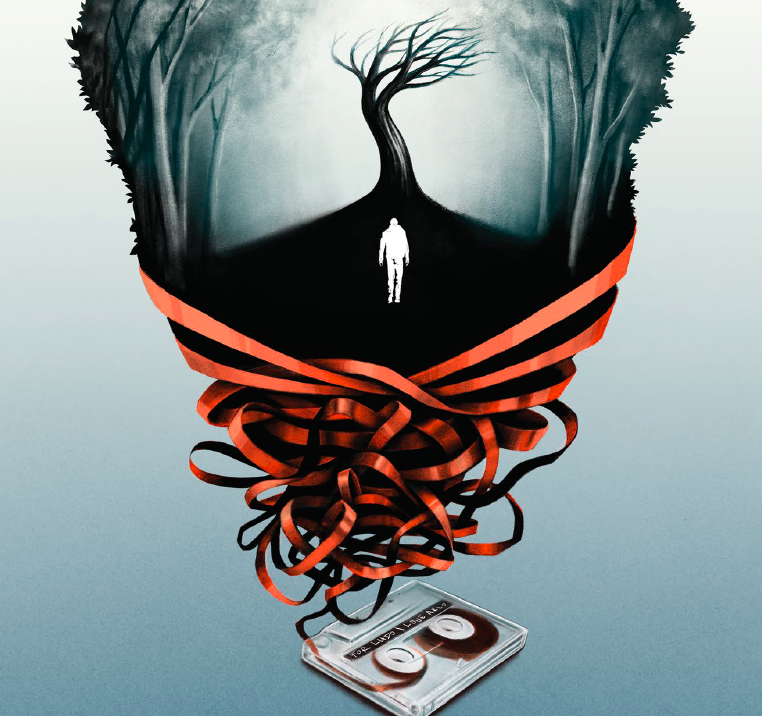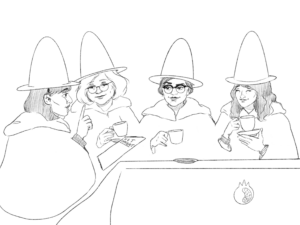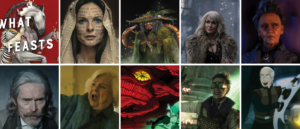Last summer I got to review the first chapter of the graphic novel At the End of Your Tether, a story of young love and mystery set against a 90s Texas backdrop, written by Adam Smith, illustrated by V.V. Glass, and colored by Hilary Jenkins. Here’s the official synopsis:
AT THE END OF YOUR TETHER is a period coming-of-age story set in the late 1990s, centering around a mystery: When a teen returns home to be reunited with a childhood friend, he discovers that she’s been missing for a week — even though he just spoke with her on the phone the day before.
To celebrate the release of the full graphic novel on February 11, 2020, I sat down with the whole creative team to talk about evoking Texas energy, writing romance, and hopping through time skips on a single page.

Rachel: As someone who is from and currently lives in the Lone Star State, I was immediately struck by the Texas setting of At the End of Your Tether. Why set this story in Texas? And how did you go about evoking a truly Texas feel?
Hilary: Having never been to Texas, I did what I usually do when starting a new book and dove into images of the area. V.V. Glass gave me lots of delicious space to play with moody skies, pelting sun, and dusty desert. As colour can play an emotive roll in the vibe of a book, I made sure to take full advantage of its effect on the atmosphere of each page. To do that, each page was hand painted in gouache and then brought into the computer and polished up.
Adam: When all this initially started, the basic premise was wanting to do something in the Noir genre. I always think of rain drenched cities when I think of those tropes so I wanted to sort of swing the other way to see if we could still invoke those feelings while setting everything in a more barren landscape. Something dry and uninviting that reflected how Arlo and Ludo felt, especially when they were apart. I’ve only been to Texas a few times, I’ve ridden through on bike trips and been to a couple of comix shows but I just leaned into my memories. Texas has this way of making you feel like your home, friends, and family are an island, with the rest of the countryside feeling impassable. This feeling that you have to hold fast to what you have for fear of it drifting off your island and out into the dry barrenlands.
V.V.: I have also never been to Texas, but I do have access to Google Maps, so I spent a lot of time virtually walking around some smaller towns and on the highway, to get a general feel, and then made it about 20% more barren. Adam clearly wanted to evoke the same sense of struggling to achieve something in an anonymous uncaring environment that Noir normally does by having the protagonist swamped by a big city, so I tried to make both the military base and the desert portions anonymous and hostile respectively. The desert, in particular, fills the function of an ocean in the story, it separates the characters completely and the journey across it is ridiculously long & grueling, so I tried to get across that immensity whenever any of the cast are trying to get from Point A to Point B.

Rachel: Can you talk a bit about setting the story on military bases? How did that inform Ludo and Arlo’s perceptions of themselves and each other?
Adam: It’s intended to give them a sense of permanence in one another. When you live on Base, everything seems temporary. Your home, school, friends, all of it can just disappear when you have to pack up and head to another place that looks eerily similar to the house you were just in. I wanted Arlo and Ludo to find something different and unique in one another and having them both come from base housing was a way to attempt a bit of character shorthand.
V.V.: The military bases are literally the same, I made two variations on house layouts and then used both for both bases, so like Adam says there’s a sense of impermanence and uniformity, and you’re not 100% sure which place you’re in at any given time. The insides of Arlo and Ludo’s houses are much more lively and lived-in than any of the establishing shots of the ‘neighbourhoods’ too, so it’s like they’re islands of life for each other in a sea of identical houses.

Rachel: One of my favorite things about this book is the depiction of romantic relationships, and how knowing how to support each other is just as important as being in love. Ludo’s parents, Benny and Myriam, are a wonderful example of that in practice, while it’s just something that Ludo and Arlo (mostly Ludo) are learning. Why did you feel like this was such an important theme to explore in Tether?
Adam: I think talking about love is sort of like finding shapes in clouds. While one person sees a horse drawn carriage, someone else might see a swarm of bees. The idea that supporting each other is the fulcrum for a solid relationship was just sort of me seeing a mouse riding a dragon. Romance comix are pretty near and dear to my heart and you always just end up making the thing that you want to see out in the world. So this idea that these two kids are learning to love in contrast to Myriam and Benny (who have clearly figured it out) was what I would have wanted to read.

Rachel: There are so many interesting moments in the book where different points in time are juxtaposed on the same page. From a visual perspective, how did y’all tackle the challenge of visually distinguishing those temporal shifts?
Hilary: It was critically important that the visuals supported the sometimes multi time frames. The use of ‘ghosted’ colour overlays and monochrome palettes was a super fun technique I rarely get to play with.
V.V.: I think the trick quite often was not distinguishing the past from the present. So there’s a few sections where, like Hillary says, we gave alternate timelines or different points in time sort of ‘glitch’ effects so they’re reminiscent of scrambled TV channels (very 90s), and you can immediately tell those aren’t reality. But there are also a lot of points where what’s presented as Ludo’s present isn’t actually at all, and that different temporality isn’t visually distinct, because the reader’s experiencing it as Ludo is.
Adam: The only thing I’ll quickly add is that this was a hard script to illustrate. V.V. and Hilary both did such an amazing job with what I can only imagine felt like a bundle of fishing line to unwind.

Rachel: This story is a very personal exploration of young love, but who are you hoping this book resonates with?
Adam: It’s strange, right? I pitched this initially because I wanted to make something my mom would pick up if she just happened upon it in a book shop. I wrote Arlo and Ludo to try and make Jasmine [Jasmine Amiri, Tether‘s editor], and V.V. fall in love with them as much as I was. And by the end, I felt like was talking to sixteen year old me, telling him to not be such a jackass. I just hope I succeeded somewhat in telling part of a good love story that would be nothing without the work of V.V., Hilary, Jasmine, and Jim [Jim Campbell, Tether‘s letterer].

Rachel: This might be a tricky one, but what was each of y’alls favorite moment in the book?
Hilary: Issue 3, page 4 when Arlo is sitting on her car having a moment.
Adam: Ooh, that is tricky. Arlo on the car hood is incredible. There’s probably a few scenes. Ludo listening to Arlo’s show while Myriam and Benny stand in the hallway is pretty high up there. Arlo’s montage at the beginning of issue three jumps out as well.
V.V.: Definitely the bit where Ludo’s sneaking around a trailer like a low-rent Philip Marlowe trying to avoid some Colourful Local Characters and an armadillo.

Rachel: Thanks so much for y’alls time! What else are you working on? Anything you’d like to plug?
Hilary: Thank you for putting together these questions! I have a few projects in the works that I am excited about, with the next book release being King of Nowhere from Boom Studios. It’s a trippy ride through a surreal world.
Adam: I’ve got an OGN called The Down River People that will be out on Archaia this year and another OGN soon to be announced that I’m very excited about. Other than that, it’s pitch pitch pitch ad nauseum. Thank you so much Rachel, Hilary, V.V., and just anyone who reads or supports this weird little book. Oh yeah, I’ve been told to make sure and say I’m on Twitter @ASmithWrites where I hardly ever say anything.
Vee: I’m working on a graphic novel series The Last Witch, (also) with Boom Studios, which I think might be the first Avatar-style kid with powers adventure set in mediaeval Ireland, but don’t hold me to that. I’m on Twitter as @ana_dapta & Instagram as anadapta too!



